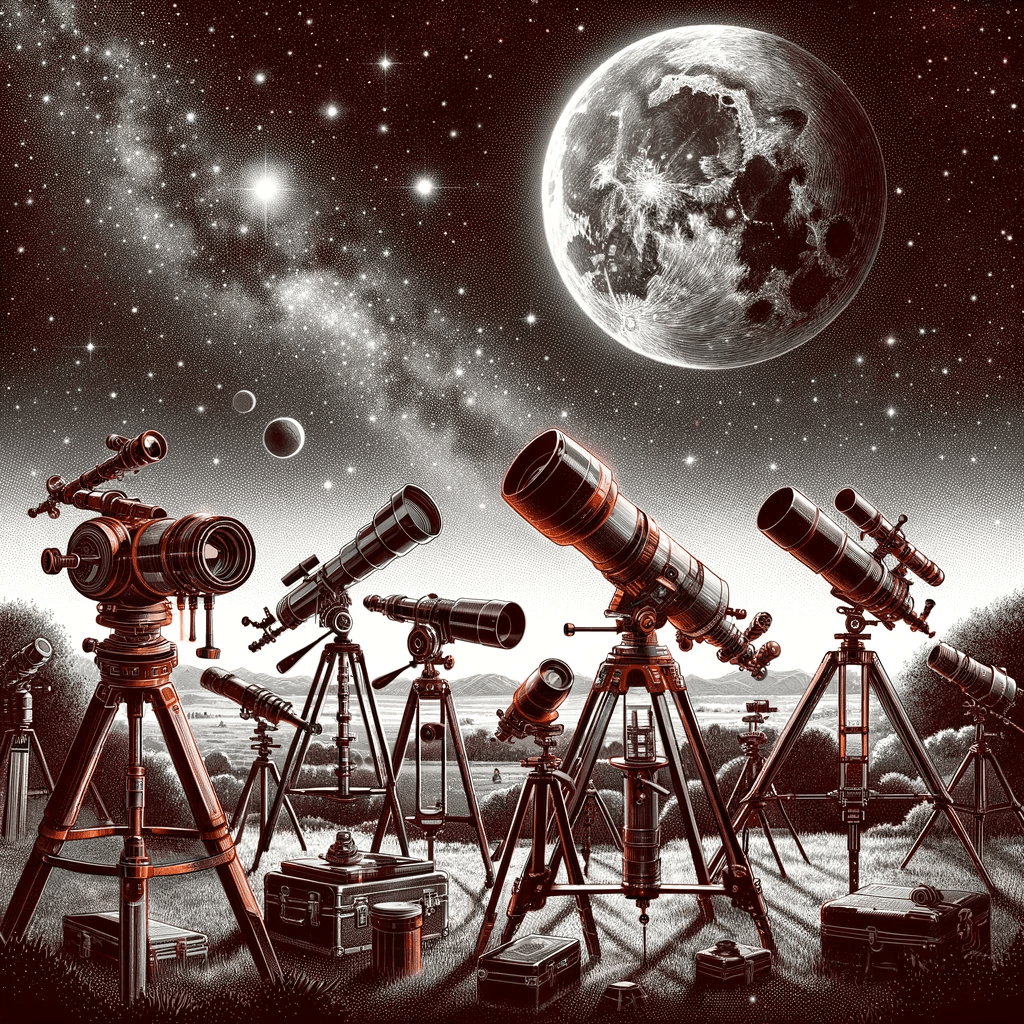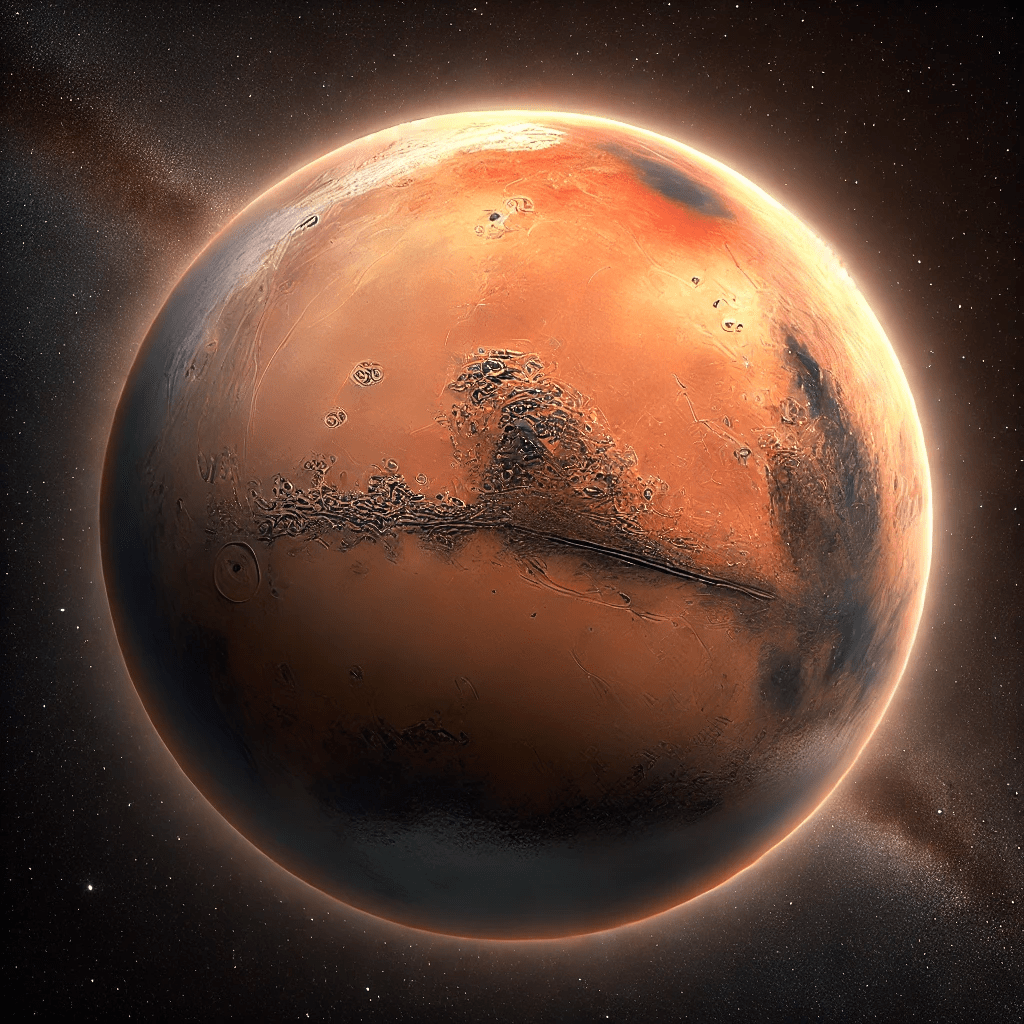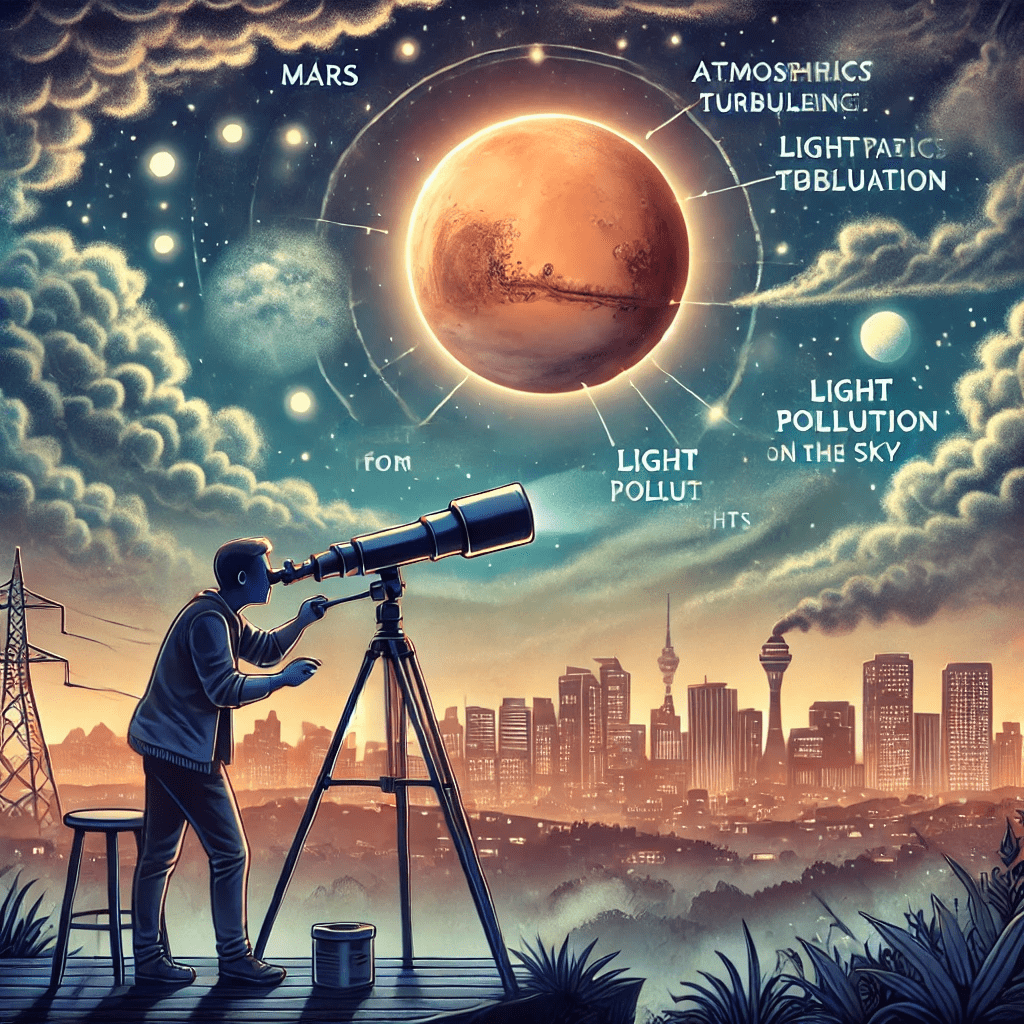Can You See Mars with a Telescope? Your Best Guide in 2025
Can you see Mars with a telescope? This question sparks a world of discovery for astronomy enthusiasts. Mars, the fourth planet from the Sun, has fascinated humanity for centuries, inspiring myths and scientific exploration. In this guide, we’ll explore how to observe Mars with a telescope, whether you’re a beginner or an experienced stargazer. We’ll cover everything from choosing the right telescope to understanding the best times to observe Mars, and how to enhance and share your viewing experience. By the end, you’ll be well-prepared to observe Mars like a pro in 2024 and beyond.

How to See Mars with a Telescope
Step 1: Choosing the Right Telescope

Can you see Mars with a telescope, regardless of its size and type? While it’s possible to see Mars with almost any telescope, the quality of your view will depend heavily on the specifications of your equipment. When choosing a telescope for observing Mars, aperture size is one of the most important factors. The aperture is the diameter of the telescope’s primary lens or mirror, and it determines how much light the telescope can gather. More light means better resolution and the ability to see finer details.
For observing Mars, a telescope with a minimum aperture of 4 inches (100mm) is recommended. This size allows you to see the planet as more than just a bright dot in the sky. With a 4-inch telescope, you can observe Mars’ reddish surface, polar ice caps, and some of its larger surface features. However, if you want to see more detail, such as surface markings and possibly even dust storms, consider a telescope with a larger aperture, such as 6 inches (150mm) or more.
There are two main types of telescopes to consider: refractors and reflectors. Refractor telescopes use lenses to gather and focus light, providing sharp images with high contrast, which is excellent for planetary viewing. However, they tend to be more expensive per inch of aperture compared to reflectors. Reflector telescopes use mirrors to collect and focus light, offering more aperture for your money, which is beneficial for viewing faint objects like Mars. Both types can give you great views of Mars, so choose the one that best fits your budget and needs.
Can you see Mars with a telescope that is smaller or less powerful? Yes, even smaller telescopes can provide a rewarding view of Mars, especially during opposition when Mars is closest to Earth. However, the image will be less detailed, and you might not be able to see some of the finer features. If you’re just starting, a smaller telescope can be a good entry point into the hobby, with the option to upgrade later as your interest and experience grow.
Step 2: Understanding the Best Times to Observe Mars

Can you see Mars with a telescope at any time, or are there specific times that are better for observation? Mars is best observed when it is at opposition, a time when the planet is directly opposite the Sun in the sky as seen from Earth. During opposition, Mars is closest to Earth, making it appear larger and brighter. This event occurs approximately every 26 months, with the next opposition happening in December 2024. This is the optimal time to observe Mars through a telescope, as the planet will be at its biggest and brightest.
However, Mars can still be observed at other times, though it will appear smaller and dimmer. The months leading up to and following opposition are also good for viewing, as Mars is still relatively close to Earth. Can you see Mars with a telescope during these times? Yes, but you may need to adjust your expectations in terms of the level of detail you can observe. As Mars moves further from opposition, it becomes smaller and more challenging to view, but it remains a rewarding target for amateur astronomers.
In addition to opposition, consider the time of night and the season when planning your observations. Mars rises in the east and sets in the west, following the same path as the Sun. The best time to observe Mars is when it is highest in the sky, typically around midnight during opposition. This is when Mars is least affected by atmospheric distortion, which can blur the image. Winter months are generally better for viewing planets like Mars because longer nights provide more time for observation, and the colder temperatures often result in clearer skies.
Step 3: Setting Up Your Telescope for Optimal Viewing

Can you see Mars with a telescope if it’s not properly set up? Setting up your telescope correctly is crucial to getting a clear, sharp view of Mars. Start by choosing a location with a stable surface and minimal light pollution. Observing from a dark site away from city lights will significantly improve your chances of seeing Mars. Light pollution can wash out faint details and make it difficult to distinguish Mars from stars.
Once you’ve chosen your observing site, set up your telescope on a stable mount. If you’re using an equatorial mount, align it with the Earth’s axis to make tracking Mars easier. An alt-azimuth mount is simpler to set up but requires manual adjustment to keep Mars in the field of view. For computerized telescopes, input the correct date, time, and location coordinates to ensure accurate tracking of Mars.
Can you see Mars with a telescope without focusing properly? No, focusing is essential for seeing details on Mars. Start by focusing on a bright star or the Moon to get the sharpest possible image, then move to Mars. Use the fine focus adjustment to tweak the focus until Mars appears as sharp as possible. Remember that atmospheric conditions, such as turbulence and humidity, can affect focus, so you may need to make small adjustments during your observing session.
Step 4: Locating Mars in the Night Sky

Can you see Mars with a telescope if you don’t know where to look? Finding Mars in the vast night sky can be challenging, especially if you’re new to stargazing. Fortunately, some tools and techniques can help you locate Mars with ease. During opposition, Mars is one of the brightest objects in the night sky, often outshining even the brightest stars. It typically appears as a reddish “star” and does not twinkle like other stars, making it easier to identify.
One of the best tools for locating Mars is a star chart or an astronomy app. Star charts are maps of the night sky that show the positions of stars, planets, and other celestial objects. You can find printed star charts online or in astronomy books, or you can use a mobile app like SkySafari or Star Walk, which can point you in the right direction based on your location and the time of night.
Another helpful technique is star hopping. Start by locating a bright star or constellation that you can easily find in the sky, and then use it as a reference point to find Mars. For example, during opposition, Mars is often located near the constellations of Pisces, Aries, or Taurus, depending on the year. Can you see Mars with a telescope if you rely solely on these tools? While they are helpful, nothing beats practice and familiarity with the night sky. The more you observe, the easier it will be to locate Mars and other planets.
Step 5: Observing Mars’ Features

Once you’ve found Mars, can you see its features with a telescope? The answer is a resounding yes, especially if you’ve followed the steps for proper setup and focusing. Mars has several distinctive features that make it a fascinating object to observe. Even with a modest telescope, you can see some of these features, and larger telescopes will reveal even more detail.
The most prominent features you can see on Mars with a telescope are its polar ice caps. These bright, white regions at the planet’s poles are made of frozen carbon dioxide (dry ice) and water ice. The polar caps are easily visible even with smaller telescopes, and their size changes with the Martian seasons, shrinking during the summer and expanding during the winter. Observing these seasonal changes can be particularly rewarding.
Another feature you can see on Mars with a telescope is the planet’s reddish surface, which is due to iron oxide (rust) in the Martian soil. This gives Mars its characteristic red color, which is visible even to the naked eye. Through a telescope, you can see variations in this color across the planet’s surface. These variations are due to different types of terrain, such as dark volcanic plains (called maria) and lighter regions covered with dust and sand.
Can you see Mars with a telescope and spot its largest volcano, Olympus Mons? While Olympus Mons is the tallest volcano in the solar system, it is challenging to see with amateur telescopes due to its location near the equator and the planet’s rotation. However, under excellent conditions and with a large enough telescope, you might catch a glimpse of this massive shield volcano.
Mars also has vast canyon systems, the largest of which is Valles Marineris. This canyon stretches over 4,000 kilometers (2,500 miles) across the Martian surface and is up to 7 kilometers (4 miles) deep in places. Can you see Mars with a telescope and observe Valles Marineris? While the canyon is too narrow to see its full depth and detail, you can sometimes spot the shadowed regions of this vast system, especially with larger telescopes.
Another interesting phenomenon to observe on Mars is its weather. Mars has a thin atmosphere, primarily composed of carbon dioxide, which allows for the formation of clouds and dust storms. Can you see Mars with a telescope and observe its weather patterns? Yes, you can! Clouds on Mars often appear as bright, white areas near the planet’s limbs (edges), while dust storms appear as yellowish or reddish clouds that can cover large portions of the planet. During a global dust storm, Mars may appear as a featureless disk, as the dust obscures the surface.
Step 6: Enhancing Your Observation with Filters and Accessories

Can you see Mars with a telescope and make the most out of your viewing experience? Absolutely, and using the right filters and accessories can significantly enhance what you see. Filters are especially useful when observing Mars because they can bring out specific features by increasing contrast and reducing glare.
One of the most common filters used for observing Mars is the red or orange filter. This filter enhances the contrast of surface features, making dark regions like Maria stand out against lighter areas. It also helps to reduce the effects of atmospheric turbulence, which can cause the image to blur.
A blue filter is another useful tool for observing Mars. This filter is particularly effective at highlighting the polar ice caps and clouds in the Martian atmosphere. The blue filter enhances these features by making them appear brighter and more distinct against the planet’s red surface.
A green filter can also be used to observe Mars, especially for enhancing the visibility of surface features and reducing the effects of chromatic aberration (color fringing) in refractor telescopes. Green filters are less commonly used than red or blue filters but can still provide valuable benefits.
Another accessory that can improve your observation is a Barlow lens. A Barlow lens increases the magnification of your telescope by 2x or 3x, allowing you to see more detail on Mars. However, be cautious when using a Barlow lens, as too much magnification can result in a blurry image if the atmospheric conditions are not ideal or if your telescope’s optics are not up to the task.
Can you see Mars with a telescope and capture images of what you observe? Yes, with the right equipment, you can take photographs of Mars through your telescope. Many amateur astronomers use a DSLR or a smartphone camera attached to the telescope’s eyepiece to capture images. There are also specialized planetary cameras available that are designed for astrophotography. Capturing images of Mars allows you to document your observations and share them with others. It also provides a way to track changes on Mars over time, such as the movement of dust storms or the growth of the polar ice caps.
Step 7: Taking Notes and Capturing Images

Can you see Mars with a telescope and document your findings? Absolutely! Keeping a detailed observation log is a great way to track your progress as an amateur astronomer and to record the features and phenomena you observe on Mars. In your log, you can note the date and time of your observation, the weather conditions, the equipment you used, and any specific features you observed on Mars. Over time, this log will become a valuable resource that allows you to see how your skills have improved and how Mars changes with each observation.
If you’re interested in astrophotography, capturing images of Mars through your telescope is an excellent way to document your observations. With the right equipment, you can take high-quality photographs of Mars that reveal its surface features, polar ice caps, and atmospheric phenomena. Many amateur astronomers use DSLR cameras or specialized planetary cameras for this purpose. You can also use a smartphone adapter to attach your phone to the telescope’s eyepiece for quick and easy photos.
Can you see Mars with a telescope and capture images that rival those taken by professionals? While amateur astrophotography equipment cannot match the capabilities of professional observatories or spacecraft, you can still take impressive photos of Mars that show a surprising amount of detail. Image stacking software, such as RegiStax or AutoStakkert, can help you enhance your photos by combining multiple exposures to create a single, clear image.
Step 8: Understanding the Challenges and Rewards of Mars Observation

Can you see Mars with a telescope without facing some challenges? Observing Mars, like all astronomical activities, comes with its set of challenges. The most common challenges include atmospheric turbulence, light pollution, and weather conditions. These factors can affect the clarity of your view, making it difficult to see fine details on Mars.
Atmospheric turbulence, also known as “seeing,” is caused by the Earth’s atmosphere and can distort the image you see through your telescope. Poor seeing conditions can cause Mars to appear blurry or to “twinkle” like a star. To minimize the effects of seeing, observe Mars when it is highest in the sky, where the atmosphere is thinner, and avoid nights with high winds or unstable weather.
Light pollution is another challenge, especially for those observing from urban or suburban areas. Can you see Mars with a telescope in a city? Yes, but light pollution can wash out faint details and make it harder to see Mars. To combat light pollution, try to observe from a dark site away from city lights, or use a light pollution filter to reduce its effects.
Weather conditions also play a significant role in your ability to observe Mars. Cloud cover, humidity, and temperature can all affect the clarity of your view. Clear, cold nights are often the best for observing Mars, as cold air is more stable and less likely to cause atmospheric turbulence. However, cold temperatures can also make observing uncomfortable, so be sure to dress warmly and take breaks to warm up if needed.
Despite these challenges, the rewards of observing Mars far outweigh the difficulties. Can you see Mars with a telescope and experience the thrill of discovering its features for yourself? Absolutely! Seeing Mars’ polar ice caps, surface markings, or a dust storm for the first time is an unforgettable experience. Each observation is a chance to connect with the cosmos and gain a deeper understanding of our place in the solar system.
Step 9: Connecting with the Astronomy Community
Can you see Mars with a telescope and share your experiences with others? Yes, and connecting with the astronomy community can greatly enhance your enjoyment of the hobby. Joining an astronomy club or online community allows you to learn from more experienced observers, share your observations, and participate in group viewing events. Many clubs organize public star parties during key astronomical events like Mars’ opposition, allowing you to observe with others and compare views through different telescopes.
Online forums and social media groups dedicated to astronomy are also great places to share your observations and learn from others. Websites like Cloudy Nights and the Astronomy Subreddit are popular platforms where amateur astronomers discuss equipment, share images, and offer advice. You can also follow astronomy-focused accounts on Instagram, Twitter, and YouTube to stay updated on the latest news and tips.
Can you see Mars with a telescope and contribute to citizen science projects? Yes, amateur astronomers play a valuable role in collecting data on Mars and other celestial objects. Projects like the Association of Lunar and Planetary Observers (ALPO) encourage amateurs to submit their observations of Mars, which are then used by scientists to study the planet’s atmosphere, weather patterns, and surface changes. Contributing to such projects allows you to be part of a larger scientific community and make meaningful contributions to our understanding of Mars.
Step 10: Preparing for Future Observations
Can you see Mars with a telescope and plan for future observations? Yes, planning ahead is essential for successful stargazing. As Mars continues its journey around the Sun, its position in the sky will change. Using astronomy software or mobile apps can help you track Mars’ movements and plan your observations. Apps like Stellarium, SkySafari, and Star Walk allow you to input your location and time, providing real-time information on the position of Mars and other celestial objects.
In addition to using apps, keeping a personal observing calendar is a great way to stay organized. Mark the dates of key astronomical events, such as Mars’ opposition, conjunctions with other planets, and favorable viewing periods. This ensures that you don’t miss any opportunities to observe Mars at its best.
Consider upgrading your equipment over time as your interests and skills develop. Can you see Mars with a telescope that you start with forever? While your first telescope may serve you well, as you gain experience, you might find yourself wanting to see more detail or explore other aspects of astronomy. Investing in a larger telescope, better eyepieces, or additional accessories can open up new possibilities for observation and photography.
Step 11: Exploring Mars with Different Wavelengths
Can you see Mars with a telescope in different wavelengths of light? Observing Mars through different filters that isolate specific wavelengths can reveal features that are not visible in regular visible light. For example, using infrared filters can help you see surface features that are less affected by the Martian atmosphere, while ultraviolet filters can highlight atmospheric phenomena like clouds and ozone.
Amateur astronomers with specialized equipment can also observe Mars in other wavelengths, such as radio or even low-frequency microwaves. While this requires more advanced equipment, it opens up a whole new way of exploring the Red Planet, allowing you to detect heat patterns, map surface temperatures, and even study the planet’s internal structure.
Step 12: Understanding Mars’ Place in Human History
Can you see Mars with a telescope and appreciate its significance in human history? Observing Mars is not just about seeing a distant planet; it’s about connecting with a long tradition of exploration and discovery. Mars has been a source of fascination for cultures around the world for millennia. The ancient Egyptians, Greeks, and Romans all observed Mars and incorporated it into their mythology and calendars.
In the modern era, Mars has been the focus of countless scientific missions, from the early flybys of the Mariner spacecraft to the rovers currently exploring its surface. Understanding this history adds depth to your observations and helps you appreciate the significance of what you are seeing.
Step 13: Preparing for Human Exploration of Mars

Can you see Mars with a telescope and imagine future human exploration? As you observe Mars, consider that this distant world might one day be visited by humans. NASA and other space agencies are planning missions to send humans to Mars, to establish a permanent presence on the planet. Observing Mars through a telescope gives you a personal connection to these future endeavors.
As you watch the polar ice caps, dust storms, and surface features of Mars, think about what it would be like to stand on its surface, looking back at Earth. Observing Mars through a telescope is the first step in a journey that could one day lead to humans walking on the Red Planet.
FAQs
1. Can you see Mars with a telescope from any location?
Yes, Mars can be observed from both the Northern and Southern Hemispheres, though the best views are from locations with dark skies and minimal light pollution. The altitude of Mars in the sky will vary depending on your latitude.
2. Can you see Mars with a telescope during the day?
While it’s technically possible, it’s very difficult to see Mars during the day due to the overwhelming brightness of the Sun. Observations are best made after sunset or before sunrise when the sky is dark.
3. Can you see Mars with a telescope if the planet is not at opposition?
Yes, Mars is visible at other times, but it will appear smaller and dimmer, making it harder to observe details. Opposition offers the best viewing conditions.
4. Can you see Mars with a telescope on a budget?
Absolutely. There are affordable telescopes available that can provide good views of Mars. Look for telescopes with at least a 4-inch aperture and good optics.
5. Can you see Mars with a telescope and a smartphone?
Yes, with the right adapter, you can attach your smartphone to your telescope and capture images of Mars. This is a great way to document your observations and share them with others.
6. Can you see Mars with a telescope and detect its moons?
While Mars’ moons, Phobos and Deimos, are very small and faint, it is possible to see them with a larger telescope and under optimal conditions.
7. Can you see Mars with a telescope in a city?
Light pollution in cities can make it harder to see Mars clearly, but it is still possible. Using filters and observing during Mars’ opposition can help improve visibility.
8. Can you see Mars with a telescope and observe seasonal changes?
Yes, regular observations can reveal seasonal changes on Mars, such as the growth and shrinkage of polar ice caps and the occurrence of dust storms.
9. Can you see Mars with a telescope and study its atmosphere?
While amateur telescopes won’t reveal the detailed composition of Mars’ atmosphere, you can observe weather patterns like clouds and dust storms.
10. Can you see Mars with a telescope if it’s cloudy?
Cloud cover will obscure Mars, so clear skies are essential for observation. Always check the weather forecast before planning your stargazing session.
11. Can you see Mars with a telescope if it’s foggy?
Fog can significantly reduce visibility, making it almost impossible to see Mars. It’s best to wait for a clear night to observe.
12. Can you see Mars with a telescope if it’s raining?
Observing in the rain is not advisable, as it can damage your equipment. Always wait for clear skies to ensure the best viewing conditions.
13. Can you see Mars with a telescope if you’re near the equator?
Yes, being near the equator can offer good views of Mars when it’s high in the sky. However, local weather conditions and light pollution can still affect visibility.
14. Can you see Mars with a telescope in extreme cold?
Yes, cold weather can improve seeing conditions by reducing atmospheric turbulence. Just be sure to dress warmly and take care of your equipment.
15. Can you see Mars with a telescope and observe its rotation?
Yes, with prolonged observation, you can notice the rotation of Mars as surface features move across the planet. This requires patience and a steady view.
16. Can you see Mars with a telescope and compare it to other planets?
Yes, Mars offers a unique viewing experience compared to other planets. Observing Mars alongside planets like Jupiter and Saturn provides a fascinating comparison of planetary features.
17. Can you see Mars with a telescope and track its orbit over time?
Yes, by observing Mars regularly, you can track its movement across the sky and its changes in brightness as it moves closer to and farther from Earth.
18. Can you see Mars with a telescope and learn about its history?
Observing Mars offers a glimpse into its geological history, with features like craters and canyons telling the story of the planet’s past.
19. Can you see Mars with a telescope and teach others about it?
Yes, sharing your observations with friends, family, or astronomy clubs is a great way to teach others about Mars and the joy of stargazing.
20. Can you see Mars with a telescope and stay updated on future missions?
Following space agencies like NASA and ESA will keep you informed about upcoming missions to Mars, which can add context and excitement to your observations.
Conclusion

Can you see Mars with a telescope? Without a doubt, yes. Observing Mars is one of the most rewarding experiences in amateur astronomy, offering a connection to the mysteries of the cosmos and the potential for future exploration. By following the detailed steps outlined in this guide, you can maximize your chances of seeing Mars in all its glory.
From choosing the right telescope to understanding the best times for observation, setting up your equipment, locating Mars, and observing its fascinating features, this guide has provided everything you need to know to start your journey. The challenges of observing Mars are outweighed by the rewards, and each observation brings you closer to understanding this distant world.
As you continue your astronomical journey, explore other celestial objects and expand your knowledge. For more insights, check out our articles on astro landscape photography and the best camera for underwater photography.
For further resources and updates on Mars and other celestial phenomena, visit NASA’s Mars Exploration Program and Sky & Telescope. Remember, each time you observe Mars, you’re not just looking at a distant planet; you’re connecting with a world that has fascinated humanity for centuries. So, set up your telescope, look up, and start exploring the wonders of Mars tonight!
